/ Blog
eCommerce Trends for 2021: How Can Your Online Store Succeed This Year?
Asiya Nayeem
Content Marketer
- DATE PUBLISHED (10/5/2021)
- READ TIME (5MIN)
How people shop and what they buy is constantly changing.
In 2020, this shift was much more prominent due to stay-at-home orders and the global COVID-19 pandemic. This brought about an unprecedented change in how brands were discovered and adopted, and accelerated the rise of e-commerce further across the globe.
In almost no time, people’s habits have changed, priorities have shifted, and consumer needs have evolved. And as an online store, it’s crucial to stay in touch with these updated eCommerce trends for 2021 and adapt your strategy to cater to your shoppers better.
We’ve been studying reports since January and have noticed some massive eCommerce trends that are guiding on how people shop in 2021 and the coming years, from how stores sell to what consumers value. We’ve condensed these insights into an easy-to-follow guide to help you set up a better eCommerce strategy to sell better.
How is selling changing?
It’s clear that brands cannot follow the status quo anymore. Consumers aren’t buying like they used to and due to this, how brands sell has drastically changed too.
TL;DR: More brands are moving online, taking more control over their selling strategy, and marketing their products to shoppers directly. However, despite this increase in direct selling, brands have still recognized the importance of diversifying sales, selling across different channels and even on third-party aggregators.
You can dive into these trends in detail below.
Trend 1: The retail to eCommerce shift is real
With coronavirus shutting stores, businesses took their selling online, bringing more convenience to how consumers shop. There has been a 22% growth driven by the massive shift from offline to online.
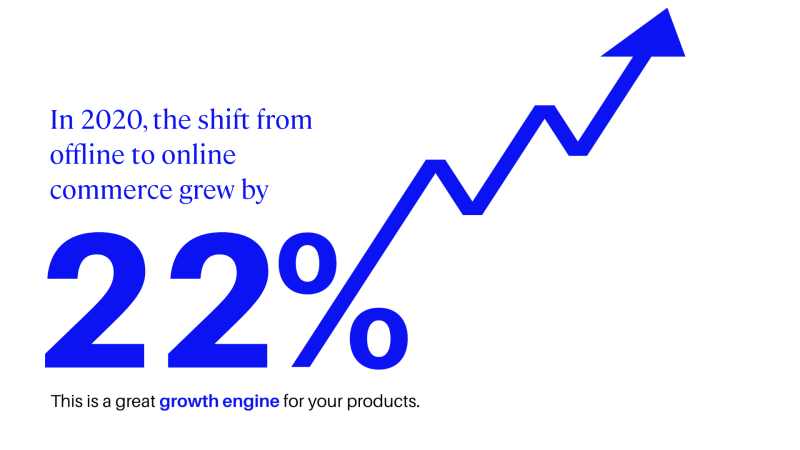
The downside? A saturated online market, with higher ad costs and a competitive search real estate.
Due to this, standing out as an online brand is trickier. But, following a few best practices can help you stay relevant.
Set up a memorable brand positioning so that shoppers can relate to you better.
Ensure that you are a niche brand. This doesn’t mean that you need to sell obscure products. Just that you need to portray values and goals that are unique to you.
From Instagram to community building to Pinterest, test different acquisition strategies to figure out what works best for your brand.
Trend 2: D2C is bringing the power back to brands
Merchants want more control over how they sell. When relying on third-party or big-box sellers, brands lose control over how they position their products and promote their offers. D2C/DTC (Direct-to-consumer) gives merchants more flexibility with their marketing and sales strategy, allowing them to sell directly.
So, rather than rely on just retail or just a third-party aggregator, selling to consumers directly gives you more say in how they perceive your brand.
Here’s a quick look at what’s possible with D2C:
More flexibility over where you list your brand.
More control over your messaging.
Ability to test and experiment with different strategies.
More data available to optimize your strategies.
Ability to build loyalty among your shoppers.
Allows you to increase customer lifetime value for your brand.
I think you will see a lot of brands move to a D2C model because they’ve realized how reliant they were on retailers.
Trevor Krehel, channel marketing manager at Seagate
Selling to consumers directly isn’t as difficult to set up. Here’s how you can go about it:
Set up your online store to allow customers to buy directly. If you’ve already set this up, you’re halfway there!
Build a positive and compelling on-site experience so that store visitors are compelled to stay and shop.
Use data to understand drop-off points and low-selling items to improve your on-site experience and keep costs lean.
Ensure that all communication with your consumer is personalized and of value to them. Generic messaging is a sure way to drive consumers away and lower repeat purchases.
Trend 3: Third-party selling is still important
Going D2C doesn’t mean you shouldn’t be selling on marketplaces and third-party channels. While you may be attracting traffic to your website, many potential customers would still be unaware of your brand and would be choosing these aggregators like Amazon to fulfil their shopping needs. Listing on these marketplaces can help you create more opportunities to sell to new sets of customers and avoid losing them to competitors.
44% of eCommerce professionals say their company is selling 3P, and nearly half of professionals see 3P as an opportunity.
Although it can add to your team’s resources, a 3P marketplace strategy provides you with one more leg to your eCommerce stool...3P also helps build internal ‘muscle,’ so that when you are ready to launch a direct-to-consumer channel, these capabilities exist.
Reid Greenberg, executive vice president of digital at Kantar.
If you aren’t already selling on third-party marketplaces, we’ll help you start:
Amazon is the first third-party channel you need to list your products on. If you have a large catalog, start by listing your popular, best-selling, and low-selling products.
Identify popular shopping channels by searching for your products on Google and studying the listings on Google Shopping. You'll find marketplaces from Etsy to Walmart and even niche third-party platforms.
Start selling and building a credible reputation through your listings or storefronts on these third-party marketplaces.
Take stock of your performance, and understand which platforms are bringing in higher revenue. Optimize your strategy based on this data.
Trend 4: Omnichannel is the future of selling
Your shoppers are everywhere and they expect you to be too. By setting up an omnichannel strategy, you can better cater to consumers on different parts of your customer journey and reach them where they discover (and re-engage) with brands.
If you aren’t familiar with omnichannel, here’s an easy explanation. Omnichannel lets you provide a customer-centric service, where you communicate with and reach your customers across different channels, creating a unified and integrated experience and ensuring you don't lose shoppers who aren't engaged with you directly (i.e. via your website).
Here’s what an omnichannel strategy would look like:
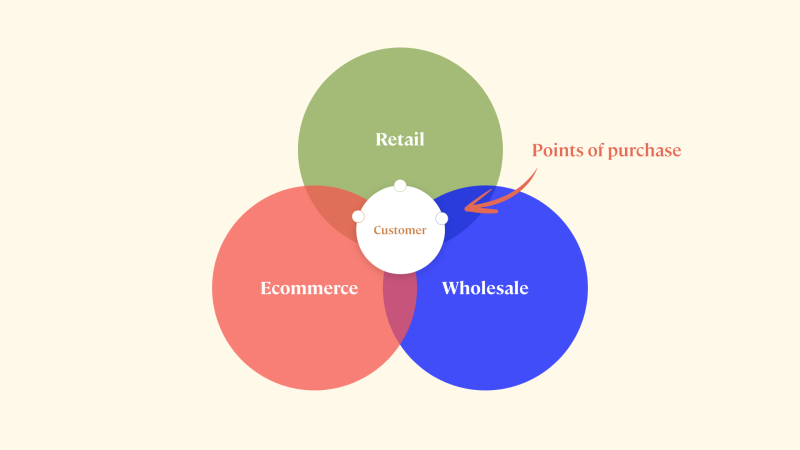
Companies with omnichannel customer engagement strategies retain 89% of their customers on average, while companies with weaker omnichannel strategies have a customer retention rate of 33%.
The future of DTC is omnichannel, only selling through one channel limits your opportunity for both brand visibility and revenue generation.
How can you set up an omnichannel strategy to engage and retain customers?
Understand shopper preferences, including where they shop from, where they discover brands, and how they want to find products.
Define your customer personas and map out ideal customer journeys to make sure that you don’t miss out on a specific acquisition or retention channel.
Set up different acquisition and retention channels that bridge the communication gap for your shoppers. You can automate your messaging across these different channels.
Make interactions meaningful by integrating unique features like loyalty programs, or make your omnichannel strategy shine with a memorable brand voice and visual identity.
Use analytics to understand how your omnichannel strategy performs, where you are losing shoppers within the customer journey, and optimize your strategy accordingly.
What do consumers value?
Everyone is talking about what tactics are working but do you really know what online consumers want and prefer?
A look at customer priorities while shopping
When buying online, shoppers have different reasons for choosing a specific brand or retailer. Some prioritize price while others prefer great service. 66% of shoppers choose a brand and its products due to its convenience rather than price or value. This shift in priority stems from the way demand over specific items has changes due to the COVID-19 pandemic.
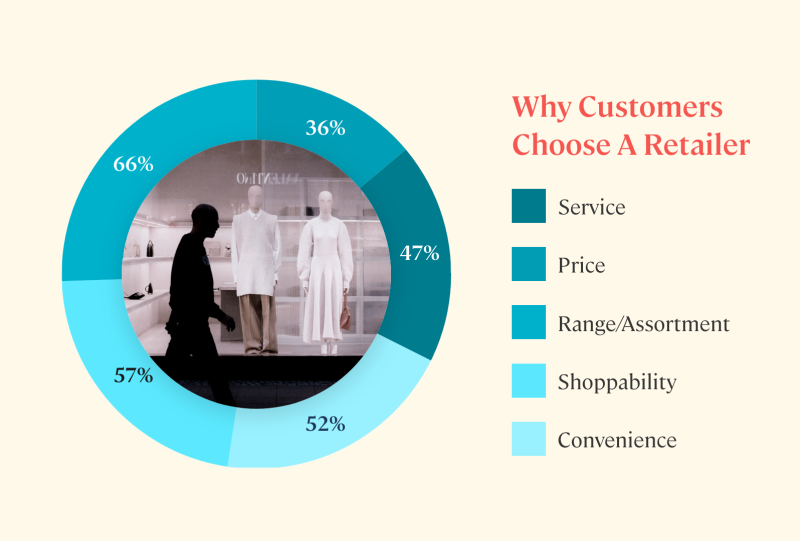
However, how your online shoppers prioritize their needs is vastly different for each one of them. You cannot assume that every shopper is looking for a convenient purchase. This is where how you sell and portray your brand can help.
Analyze Checkout Flow: Understand how easy it is for shoppers to checkout from your eCommerce store. Remove friction with one-click login and after-pay solutions.
Analyze Discount Adoption: Study the ideal price points for each product by looking at your discounts. Re-analyze your pricing strategy if your shoppers tend to only buy your products at a highly discounted price.
Sustainability is the new mantra
Consumers are more environmentally conscious in this age, expecting brands to carry this sustainability-first approach within their practices.
70% of online purchasers are aware if the packaging they receive from an eCommerce order is recyclable or not, and when it is, 80% of those consumers, in turn, are recycling.
Even Amazon has promised that it would be net-zero carbon 10 years before the Paris Agreement’s goal, making sustainability an achievable goal for eCommerce brands.
You don’t need to scrap your plastic packaging and start from scratch. You can achieve your sustainability goals through small, actionable steps:
While ordering your next batch, choose recyclable, paper-based packaging.
Rethink your manufacturing and what you put into your products. Use manufacturing cycles to make changes to your products.
Inform consumers about your plans to go sustainable and how you plan to achieve this.
Incorporate your sustainability-first messaging into your product detail pages, your “About” pages, and even on your packaging.
Refining your customer experience can influence sales.
40% of industry professionals agree that the biggest opportunity in eCommerce marketing in the next five years is improving the user experience forecasting.
Your on-site experience must make your shoppers eager to return to shop from you. By focusing on and testing your user experience, you can increase engagement and funnel your customers better, from home page to product page to checkout.
25% of brands will achieve statistically significant advances in CX quality in 2021. If you aren’t one of these brands, you'll lose out on revenue opportunities and lower your chances of converting a store visitor into a customer.
Let’s look at one of the most important parts of improving your customer experience— the customers’ touchpoints on your online store that bring in sales.
A customer touchpoint is any time a potential customer comes in contact with your brand from landing on your site to successfully completing checkout.
1. Understand their pre-shopping touchpoints
Very few merchants are aware of how their customers land on their eCommerce stores. By not understanding how you acquire these shoppers, you miss out on potential audiences that you could capture and focus on channels that reap little returns.
Kantar’s State of eCommerce 2021 Report showed that 46% of shoppers conduct an internet search before they end up buying from a brand. However, the most successful channel to capture more purchases is through emails. 51% of shoppers saw an email ad before they ended up ordering from the brand.
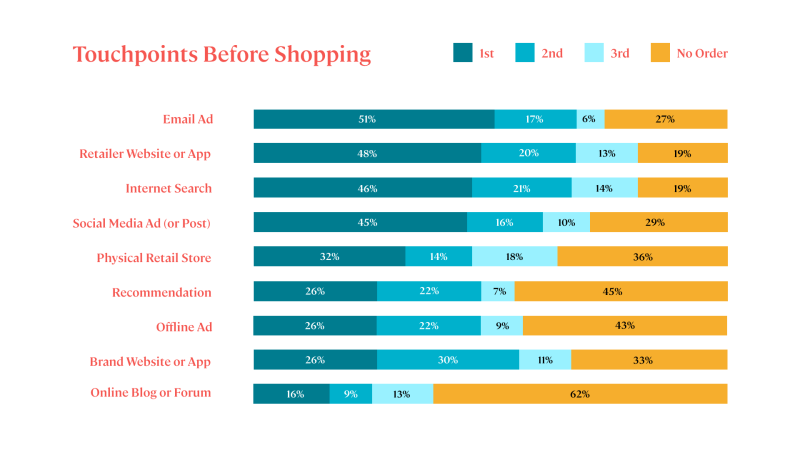
Here’s how you can optimize your acquisition strategy and improve conversions:
Send emails to past customers. Engage and delight them through promotions.
Optimize your eCommerce store to rank for relevant keywords.
Set up Google Shopping to show your product listings for relevant keywords.
2. Optimize the product detail page for better conversions
Kantar’s State of eCommerce 2021 Report also gave insights into which part of the on-site experience converted visitors into customers. The touchpoint with the highest influence over buying was the product detail page, where shoppers get a better idea of what the product is.

How does this help you improve your on-site experience? It shows that you have to optimize your product detail page and prioritize it over any other touchpoint in the buyer journey. Most merchants set up a very standardized product detail page.
You have to improve how your product detail page functions:
Test new visual formats (like 3D product images and videos).
Use better descriptions and extensive details to reel the shopper in.
Place your “Add to Cart” button above the fold.
Build credibility over your product with reviews.
3. Improve product discoverability with search
After the product detail page, the most important touchpoint is the search bar.
40% of online purchasers use search at the time of purchase, and 30% of those that ranked any touchpoint as most influential say search has the biggest influence on their purchase.
By optimizing your search, you can introduce a frictionless shopping experience and help customers finding what they're looking for. This is a big competitive advantage.
We aren’t just talking about on-site search here. 64% of online purchasers own a voice-enabled device, showing just how important it is to optimize your eCommerce store for voice searches too.
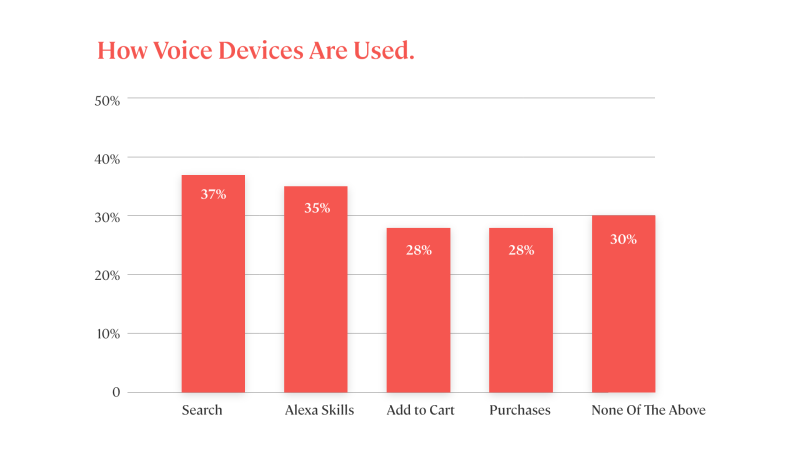
While enhancing the on-site search experience, here are some best practices:
Set up autocomplete within your search bar for faster search results.
Leverage empty search results page to ensure you don’t lose shoppers.
Optimize your site for voice search.
Set up search filters to allow shoppers to narrow down their search.
How can merchants succeed in 2021?
What would help merchants tip the scale in their favor? Tapping into opportunities available to your eCommerce store is all about retaining existing customers and using data to pinpoint sales opportunities.
Let’s look at how these 2 factors can help you grow your business.
By using loyalty and retention
In late 2020, paid search spiked 17%, and paid social advertising increased by 24%. With higher competition and more saturation in the market, merchants need to be smart about how they earn more revenue and ensure they have higher conversions for lower costs.
Many merchants will focus on loyalty and customer retention in 2021. Spend on loyalty and retention marketing will increase by 30% as CMOs assert control over the full customer lifecycle.
Historically, just improving customer retention by 5% has helped brands increase profits by 25% to 95%. Following this success metric, you can set up a retention-centric sales strategy to keep your past customers engaged and boost repeat purchases on your eCommerce store.
Here’s how a customer retention strategy could look like:
Communicate with your existing customers through email, SMS, or web push, delivering value through your messages and building a relationship with them.
Set up a loyalty program to make shopping easier for your customers. Offer rewards to past customers just for having bought from you in the past.
Show personalized recommendations on-site and within your emails to nudge purchases and encourage people to shop more.
Set up triggered drip campaigns that remind shoppers about items they have looked at or left behind in the cart.
By crowning Data, the one true king
Not all eCommerce trends will work out in your favor.
Since these are only predictions of what would help you succeed, you cannot blindly implement these insights and expect them to work.
Having better data analytics is the key to growth. Instead of throwing different strategies on the wall to see what sticks, you need to primarily look at your own data to understand its performance and use these learnings to optimize your strategy.
56% of eCommerce professionals are allocating funds to data and analytics, making it the top eCommerce service budgeted for.
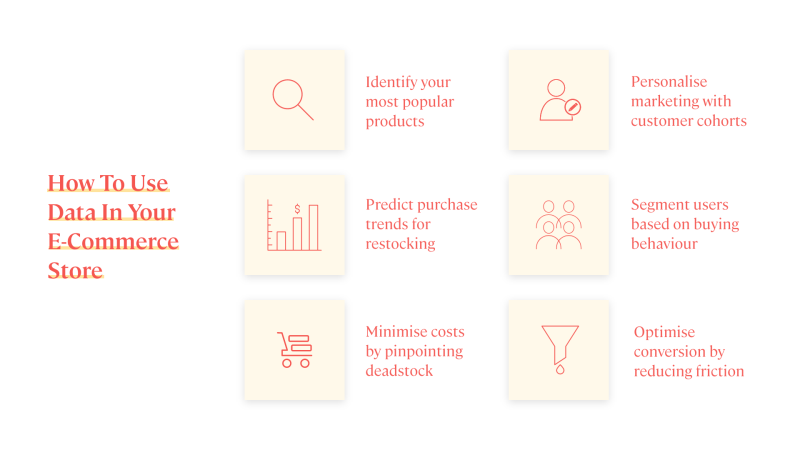
Setting up your data analytics is easy. Tools like Google Analytics, littledata, and Daasity are built to make your store’s performance more accessible and help you pinpoint problem areas.
Here are some data points you can keep track of:
Product Popularity: Identify bestsellers, to anticipate low stocks and limit deadstocks.
Checkout Behavior: Use the behavior flow to understand how shoppers are navigating through your website and where they are dropping off.
Marketing Campaign Performance: Understand how different marketing channels and campaigns are performing, and which ones brought in higher AOV and revenue.
Heatmaps: Use heatmaps to understand which parts of your website have higher engagement (content-wise) and where you need to improve.
What can you expect from marketing?
Your digital marketing and automation strategy, when done right, can unlock unlimited opportunities for growing your sales But implementing it well takes time and insights.
Understand your customer's social behavior
Shoppers now find products and brands in non-traditional spaces.
According to one study, 40% of shoppers discover a new brand through recommendations from family/friends. For 39% of shoppers, following or admiring a brand is crucial to be incentivized to shop from them. Influencers are still relevant since 35% of shoppers follow and buy from brands, mentioned by influencers.
Here’s a quick look at how shoppers discover brands:
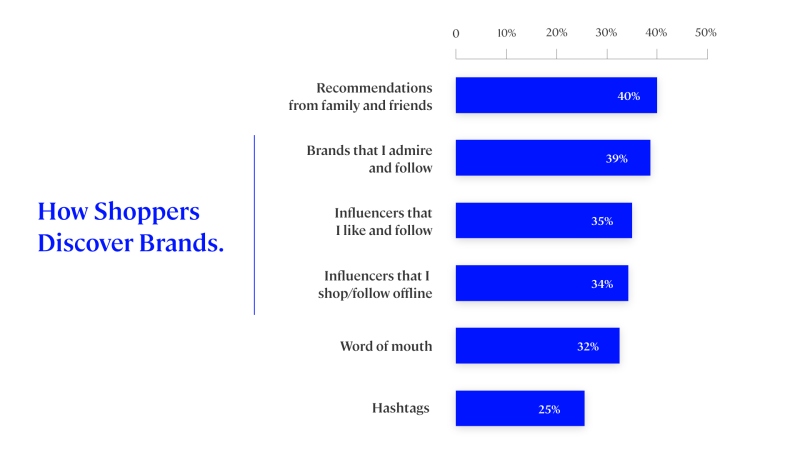
Now, how does this change the way you market and reach new shoppers?
Here are some best practices to include within your eCommerce marketing strategy for 2021 if you haven’t already:
Prioritize referral marketing and reward customers for referring new shoppers.
Create value through useful and engaging content on social media (buying guides).
Partner with micro-influencers (if you have the budget) for better impact and returns.
Set up pop-ups and offline experiences to bring awareness to your brand.
Choose marketing that converts (like social commerce!)
One assumption that we've all had is that Facebook is not as relevant as before. But, surprisingly, Facebook is still relevant (and continues to bring revenue). In fact, 72% of eCommerce professionals use Facebook for digital marketing activities.
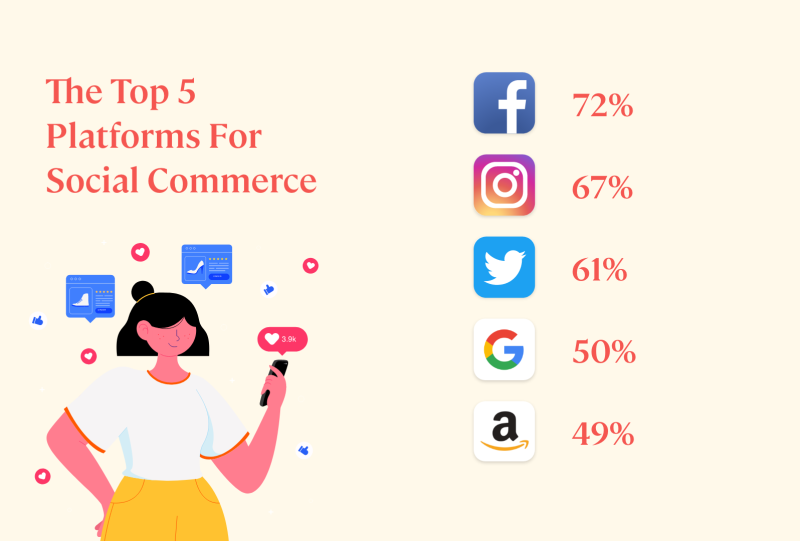
What's more, 61% of shoppers are likely to buy from social sites in the future.
Social commerce is booming and by not showing who you are as a brand and allowing shoppers to buy through social media, you miss out on acquiring new customers. Setting up a social commerce strategy isn’t tedious. Here’s how we recommend you start:
Start actively posting unique and value-driving content on social media.
Enable social commerce and use tools to connect your catalog to your social channels.
Engage with your audience, follow them and build a community.
Analyze how different platforms are working. Optimize your strategy and focus more on platforms that are bringing in revenue.
Use these eCommerce trends for 2021 to improve your strategy.
We hope this guide helps you understand the different opportunities available to you to grow your eCommerce store. By leveraging these consumer trends, you can optimize different aspects of your store, from user experience to marketing, and effectively increase your sales.
What are your go-to ideas for amping up eCommerce sales? Let us know!